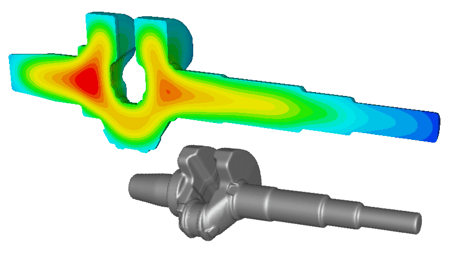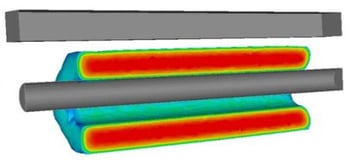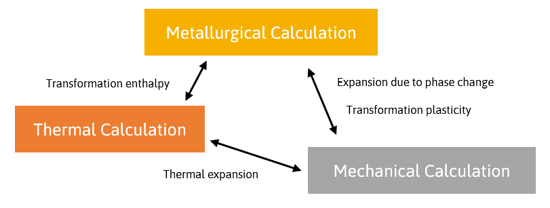What is quenching?
Quenching is a heat treatment process used to modify the mechanical properties of forged, cast or welded parts. It consists in heating a metal part to change its microstructure and properties such as hardness, strength, and toughness. Thus, the part is quickly cooled in a medium which can be water, oil, polymer-based or air, depending on the material and the expected properties.
This process is commonly used to harden and strengthen parts for the automotive and aerospace industries such as rings, gears, shafts and other transmission parts. It is also used in the construction industry to avoid distortions of bars and rods and in the energy sector (e.g. seamless rolled rings).

Temperature evolution during oil quenching of a single cylinder crankshaft. Courtesy of AMW.
Simulating quenching with SIMHEAT®
Heat treatment temperatures and cooling rates are very important factors in the manufacturing of forged and cast metal parts. They grant the material most of its final characteristics. Numerical simulation is an excellent tool for understanding and optimizing these results.
To keep as close as possible to reality, SIMHEAT® software integrates a model that couples thermal, mechanical and metallurgical phenomena. More information
Thus, it considers solid-state behaviors and integrates heat transfer coefficient laws depending on the surface temperature or time.
In quenching, the heat transfer coefficient depends on the part temperature, cooling medium, bath agitation and many other parameters. During the quenching process, different boiling phases occur. In SIMHEAT®, the boiling phenomenon is taken into account by using a heat transfer coefficient function of the part’s temperature.
Temperature distribution during quenching of a bevel gear with SIMHEAT®
Benefits of a predictive simulation
Numerical simulation helps to optimize your process and find the best process parameters to get the desired final characteristics. To reinforce the stability and the efficiency of the process, simulation makes it possible to test multiple quenching conditions including the heating cycle time, heat transfer coefficients, cooling curves, quenching time, nature of the bath, etc.
SIMHEAT® lets you:
- Generate the Kirkaldy-based TTT diagram for low-alloy steel grades
- Access distortion models applicable to all kind of metals including aeronautical alloys
- Track material characteristics during heat treatment thanks to sensors
- Predict temperature, phase transformation, HV or HRC hardness, distortion, residual stress and yield stress
- Model quenching and artificial ageing of aluminum alloys

Prediction of different phenomena during quenching of a gear.
Top-left corner: Martensite / Top-right corner: Hardness /
Bottom-left corner: Von Mises stress / Bottom-right corner: Equivalent strain
Competitive features of SIMHEAT® for quenching
- SIMHEAT® integrates a thermal, mechanical, and metallurgical coupled model.
- An optimization module is integrated into SIMHEAT®. It is used to fit heat transfer coefficients to experimental cooling curves by means of an inverse analysis method.
- A TTT and CCT diagram generator is available.

TTT and CCT diagram generator
- SIMHEAT® steel quenching simulation is based on a TTT diagram. Manual or automatic optimization can be used to create the TTT diagram that matches the experimental CCT curves.
- A rich quenchant data base is available in our store. It includes air, water and oil baths as well as 63 of Quaker Houghton quenchants among which a selection of polyalkylene glycol solution with different concentrations, temperatures and agitation conditions. For each quenchant, a description has been added that shows the HTC values as a function of temperature and the fit between the experimental data and the simulation curve obtained during optimization.

Temperature distribution during quenching of a metal ingot in a water bath
- Sensors can be used to record the temperature, phase transformation and hardness evolution on the metal.
- Full compatibility with JMatPro® material software to accurately analyze mechanical properties linked to phase changes and geometrical variations.
The thermo-mechanical-metallurgical model in SIMHEAT®

SIMHEAT® software has a thermal, mechanical, and metallurgical coupled model. The mechanical model is represented by an elasto-viscoplastic behavior law. The thermal parameters as well as the elastic and plastic parameters vary with respect to phases and temperatures. The metallurgical model concerns the computation of the phase transformation kinetics during cooling of a part and is based on an isothermal model. Incubation of ferrite, pearlite and bainite is represented by a Scheil parameter.

t(T) is the time needed for the transformation starting at temperature T.
A Johnson-Mehl Avrami law is used to compute the fraction of ferrite, pearlite or bainite transformed.

Where:
- y is the transformed fraction for each phase
- ymax is the maximum phase fraction which can be a transformed function of the temperature
- t is the elapsed time since the growth began
- b and n are the Avrami law coefficients
The isothermal model is coupled to deal with the non-isothermal aspects of the cooling. Martensitic transformations are predicted with the Koistinen-Marburger law. The martensite volume fraction is a function of the temperature. The martensitic transformation starts when unstable austenite dips below the temperature level MS (Martensite Start). The metallurgical transformation is coupled with the thermal computation through the transformation enthalpy of each phase.
 Simulation of martensite rate with SIMHEAT® during quenching of a crankshaft
Simulation of martensite rate with SIMHEAT® during quenching of a crankshaft
Also well-suited for aluminum alloys
As aluminum has a low density, it often needs to be heat-treated to obtain the necessary mechanical properties. Quenching and artificial ageing are suitable for this material and SIMHEAT® integrates two models to offer a predictive simulation: a phenomenological model and a thermomechanical model.
In partnership with a sector’s leader in quenchants
Transvalor and Quaker Houghton, leader in manufacturing industrial process fluids to the primary metals and metalworking markets, work on joint projects to improve the performance of quenchants and lubricants.
This partnership allows Transvalor to continuously enhance the predictive state of heat treatment simulations made with SIMHEAT®.
READ MORE ABOUT THIS PARTNERSHIP >




